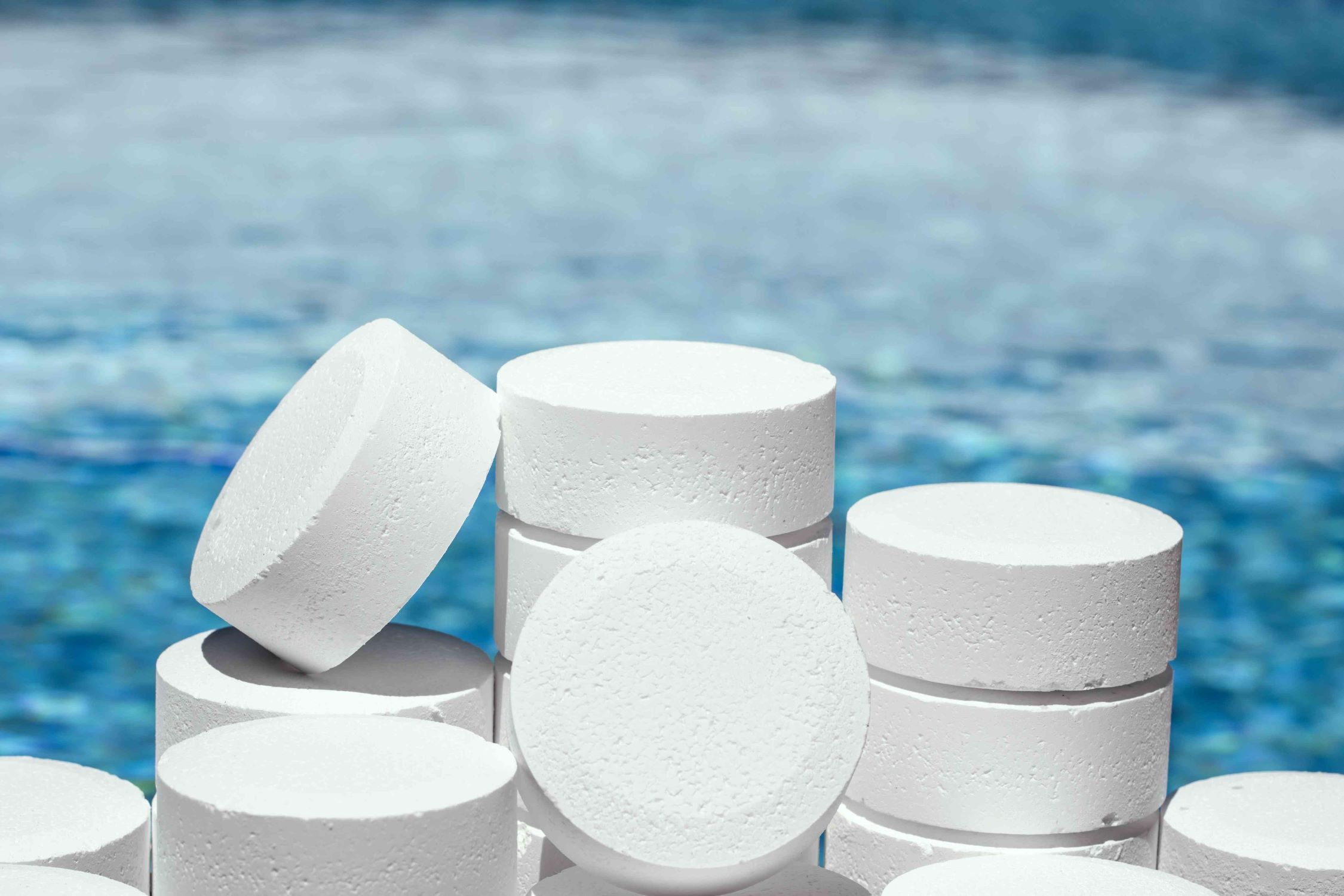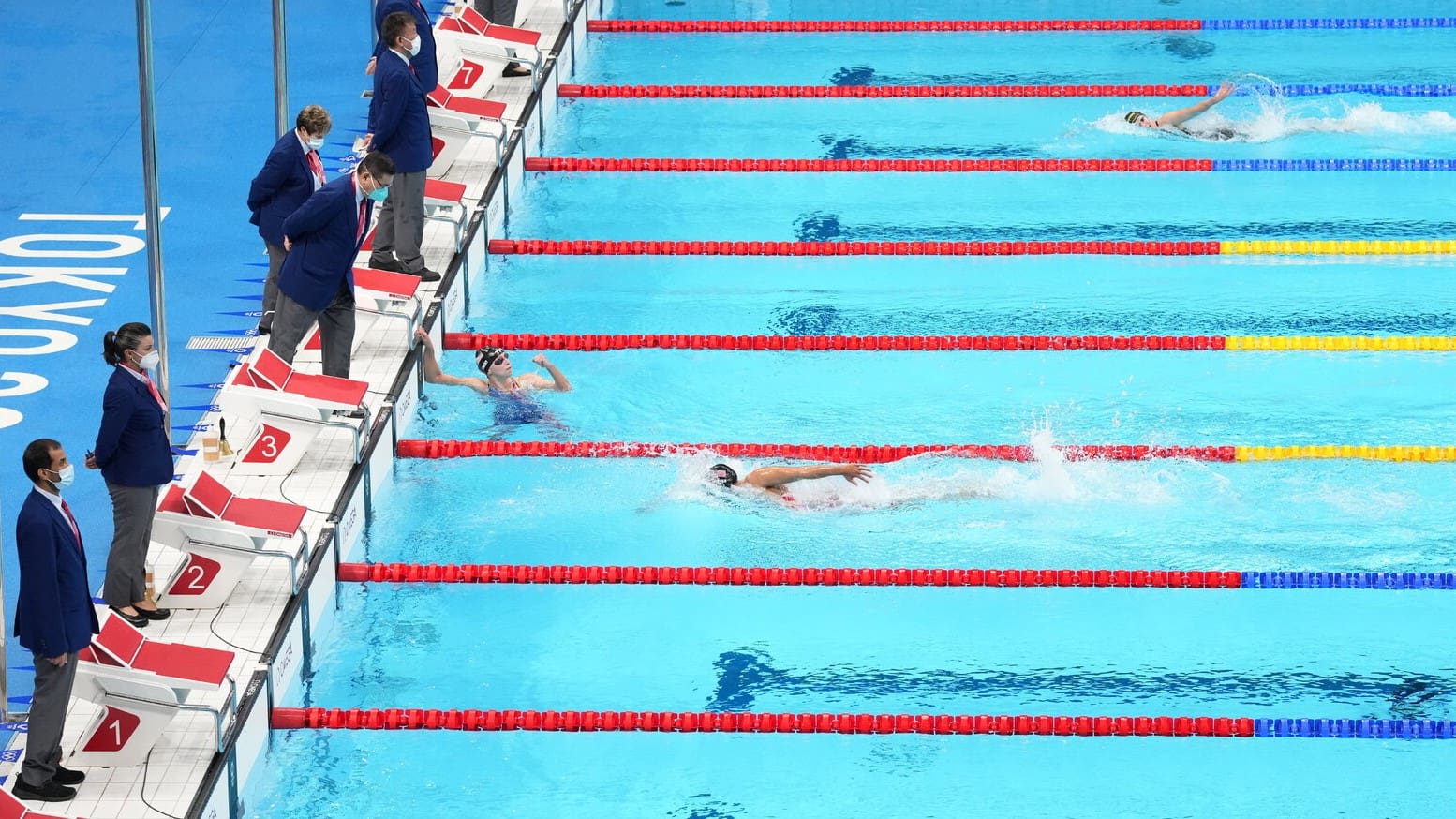Home>Gardening & Outdoor>Outdoor Recreation & Activities>What Makes Swimming Pool Water Blue


Outdoor Recreation & Activities
What Makes Swimming Pool Water Blue
Published: February 18, 2024
Discover the science behind the mesmerizing blue color of swimming pool water. Learn how outdoor recreation and activities contribute to this stunning visual effect. Unlock the secrets of the perfect poolside experience.
(Many of the links in this article redirect to a specific reviewed product. Your purchase of these products through affiliate links helps to generate commission for Storables.com, at no extra cost. Learn more)
Introduction
Swimming pools have an irresistible allure, drawing people of all ages to bask in the refreshing embrace of crystal-clear water. The mesmerizing blue hue of pool water is a defining feature that evokes a sense of tranquility and relaxation. Have you ever wondered what makes swimming pool water appear so invitingly blue? The answer lies in a fascinating interplay of various factors, including the presence of chlorine, pH levels, sunlight, and the efficiency of filtration systems. Understanding the intricate dynamics behind the captivating blue color of pool water unveils the meticulous care and science that goes into maintaining a pristine aquatic oasis.
The captivating allure of a swimming pool is often attributed to the mesmerizing blue color of its water. However, the factors contributing to this enchanting hue are multifaceted and intriguing. Delving into the realms of chemistry, light dynamics, and maintenance practices unravels the secrets behind the alluring blue tint that beckons swimmers to immerse themselves in its embrace.
The journey to unravel the mysteries of swimming pool water begins with an exploration of the role of chlorine, the impact of pH levels, the influence of sunlight, and the importance of filtration. Each of these elements plays a pivotal role in shaping the mesmerizing blue color that transforms a pool into a captivating aquatic haven. Let's embark on a captivating exploration of the science and artistry that converge to create the enchanting allure of swimming pool water.
Key Takeaways:
- 1. The mesmerizing blue color of swimming pool water comes from a careful balance of chlorine, pH levels, sunlight, and filtration systems, creating a captivating oasis for swimmers to enjoy.
- 2. Chlorine fights off algae and bacteria to keep the water blue, while pH levels, sunlight, and filtration systems also play key roles in maintaining the inviting hue of swimming pool water.
Read more: What Kills Water Bugs In A Swimming Pool
The Role of Chlorine in Pool Water
Chlorine serves as the unsung hero in the realm of pool maintenance, playing a pivotal role in preserving the pristine blue hue of the water. This powerful chemical agent acts as a formidable guardian, diligently combating the intrusion of algae, bacteria, and other contaminants that threaten to compromise the clarity and purity of the pool water.
When chlorine is introduced into the pool, it embarks on a relentless mission to neutralize harmful microorganisms, thereby preventing the water from turning murky or green. This sanitizing superhero achieves this feat by effectively oxidizing organic matter and impeding the proliferation of algae, which could otherwise taint the water with an unsightly greenish tint.
Moreover, chlorine operates as a potent disinfectant, eradicating harmful bacteria and viruses that may find their way into the pool. By neutralizing these microscopic threats, chlorine ensures that the water remains safe and hygienic for swimmers, thereby upholding the pristine blue allure that beckons them to take a refreshing plunge.
However, it is essential to strike a delicate balance in maintaining the chlorine levels. While an inadequate amount of chlorine can render the water susceptible to contamination, an excessive concentration can lead to an overpowering chemical odor and irritate the eyes and skin of swimmers. Therefore, meticulous monitoring and regulation of chlorine levels are imperative to sustain the captivating blue color of the pool water while ensuring a safe and enjoyable swimming experience for all.
In essence, chlorine emerges as the stalwart guardian of the pool water, diligently safeguarding its mesmerizing blue hue by thwarting the encroachment of algae, bacteria, and other impurities. Its unwavering vigilance and sanitizing prowess are indispensable in preserving the pristine allure of the pool, inviting swimmers to immerse themselves in the refreshing embrace of its captivating blue waters.
The Impact of pH Levels on Water Color
The mesmerizing blue color of swimming pool water is not solely attributed to the presence of chlorine; rather, it is intricately linked to the delicate equilibrium of pH levels. The pH scale, ranging from 0 to 14, serves as a barometer of the water's acidity or alkalinity, with 7 representing neutrality. In the context of pool maintenance, maintaining the pH levels within the ideal range of 7.2 to 7.8 is crucial for preserving the captivating blue hue of the water.
When the pH levels deviate from this optimal range, the visual appeal of the pool water can undergo a remarkable transformation. A lower pH level, indicative of increased acidity, can impart a somewhat cloudy or dull appearance to the water, detracting from its enchanting blue allure. Conversely, a higher pH level, signaling heightened alkalinity, may cause the water to assume a greenish or murky tint, diminishing its captivating visual appeal.
The impact of pH levels on water color is intricately intertwined with the behavior of chlorine. In an environment where the pH levels are excessively low or high, the efficacy of chlorine is compromised, impeding its ability to sanitize the water effectively. Consequently, maintaining the pH within the recommended range not only sustains the mesmerizing blue color of the pool water but also optimizes the sanitizing prowess of chlorine, ensuring a safe and hygienic swimming environment.
Moreover, the influence of pH levels extends beyond the visual aesthetics of the water, permeating the sensory experience of swimmers. Water with imbalanced pH levels can provoke skin and eye irritation, detracting from the enjoyment of the swimming experience. By upholding the ideal pH range, pool owners not only preserve the captivating blue allure of the water but also cultivate a comfortable and inviting environment for swimmers to revel in.
In essence, the impact of pH levels on water color transcends mere visual aesthetics, permeating the realms of water quality and swimmer comfort. By meticulously regulating the pH levels within the recommended range, pool owners can safeguard the captivating blue hue of the water, optimize the efficacy of chlorine, and foster a delightful swimming experience for all who are drawn to the enchanting embrace of the pool's pristine waters.
The blue color of swimming pool water is due to the reflection and absorption of light. The water absorbs the longer wavelengths of light (like red and yellow) and reflects the shorter blue wavelengths, making the water appear blue.
The Influence of Sunlight on Water Color
The mesmerizing blue color of swimming pool water is not solely a product of chemical treatments and pH regulation; it is also profoundly influenced by the radiant embrace of sunlight. The interplay between sunlight and water gives rise to a captivating spectacle, as the sun's rays interact with the pool water, bestowing it with an enchanting azure hue that beckons swimmers to immerse themselves in its refreshing embrace.
Sunlight comprises a spectrum of colors, with each wavelength interacting uniquely with the water. When sunlight penetrates the pool water, the longer wavelengths, such as red and orange, are absorbed, while the shorter wavelengths, including blue, are scattered and refracted. This phenomenon, known as Rayleigh scattering, is pivotal in shaping the captivating blue color of the water. The scattered blue wavelengths converge to create a visual symphony that captivates the eye, imbuing the water with an alluring azure tint that epitomizes the essence of aquatic allure.
Furthermore, the intensity and angle of sunlight play a pivotal role in accentuating the enchanting blue hue of the pool water. When sunlight cascades onto the water at a steep angle, the scattering of blue wavelengths is optimized, intensifying the mesmerizing blue color that entices swimmers to partake in its refreshing allure. Conversely, during the twilight hours or when sunlight is obscured by cloud cover, the interplay of wavelengths is subdued, resulting in a subtle shift in the water's coloration.
The influence of sunlight on water color transcends mere visual aesthetics, permeating the sensory experience of swimmers. The radiant warmth of sunlight, coupled with the captivating blue hue of the water, creates an inviting ambiance that beckons swimmers to revel in the tranquil embrace of the pool. Moreover, the interplay of sunlight with the water's surface engenders a mesmerizing dance of light and shadow, further enhancing the allure of the pool environment.
In essence, the influence of sunlight on water color is a testament to the harmonious interplay of natural elements, bestowing swimming pool water with an enchanting azure hue that captivates the senses. The radiant embrace of sunlight, coupled with the captivating interplay of wavelengths, converges to create a visual symphony that transforms the pool water into a captivating aquatic oasis, inviting swimmers to immerse themselves in its refreshing allure.
The Importance of Filtration in Maintaining Blue Water
The captivating blue color of swimming pool water is not merely a product of chemical treatments and sunlight; it is also intricately linked to the efficiency of filtration systems. Filtration serves as a stalwart guardian, diligently purging the water of impurities and debris that could compromise its pristine allure. The seamless interplay of filtration mechanisms, encompassing skimmers, pumps, and filters, orchestrates a symphony of purification that sustains the mesmerizing blue hue of the water, inviting swimmers to revel in its refreshing embrace.
Skimmers stand as the vanguards of filtration, steadfastly patrolling the water's surface to ensnare leaves, insects, and other debris that threaten to mar its visual appeal. By capturing these intruders before they can sink and disintegrate, skimmers prevent the water from assuming a murky or discolored appearance, preserving its captivating blue allure. Moreover, the diligent removal of surface debris mitigates the burden on the filtration system, optimizing its efficiency in maintaining the water's pristine clarity.
Pumps emerge as the indefatigable heartbeats of the filtration process, orchestrating the relentless circulation of water through the filtration system. This ceaseless movement not only facilitates the distribution of sanitizing agents, such as chlorine, but also propels the water through the filtration medium, where impurities are meticulously ensnared and eradicated. The harmonious synergy between skimmers and pumps engenders a dynamic purification dance that upholds the captivating blue hue of the water, inviting swimmers to immerse themselves in its refreshing embrace.
Filters serve as the unsung heroes of the filtration triad, diligently trapping microscopic impurities and contaminants that elude the vigilant gaze of skimmers. Whether in the form of sand, diatomaceous earth, or cartridge elements, filters meticulously purify the water, ensuring that it remains free from the unsightly discoloration that could detract from its visual allure. The seamless collaboration between skimmers, pumps, and filters culminates in a harmonious purification ballet that sustains the captivating blue color of the water, beckoning swimmers to partake in its refreshing embrace.
In essence, the importance of filtration in maintaining blue water transcends mere purification; it embodies a meticulous choreography of skimmers, pumps, and filters that safeguards the pristine allure of the pool water. The seamless interplay of these filtration mechanisms orchestrates a symphony of purification that sustains the mesmerizing blue hue of the water, inviting swimmers to revel in its refreshing embrace.
Read more: What Ppm Chlorine In Swimming Pool Water
Conclusion
The captivating allure of swimming pool water, characterized by its mesmerizing blue hue, is a testament to the intricate interplay of various factors that converge to create a pristine aquatic oasis. From the vigilant guardianship of chlorine to the delicate equilibrium of pH levels, the radiant embrace of sunlight, and the efficient orchestration of filtration systems, each element plays a pivotal role in shaping the enchanting allure of the pool water.
Chlorine emerges as the stalwart defender, tirelessly combating the intrusion of algae, bacteria, and contaminants that threaten to compromise the water's clarity and purity. Its sanitizing prowess ensures that the water retains its captivating blue hue, inviting swimmers to immerse themselves in its refreshing embrace. Moreover, the delicate balance in maintaining chlorine levels is imperative to sustain the captivating allure of the pool water while ensuring a safe and enjoyable swimming experience for all.
The impact of pH levels on water color transcends mere visual aesthetics, permeating the realms of water quality and swimmer comfort. By meticulously regulating the pH levels within the recommended range, pool owners can safeguard the captivating blue hue of the water, optimize the efficacy of chlorine, and foster a delightful swimming experience for all who are drawn to the enchanting embrace of the pool's pristine waters.
The influence of sunlight on water color is a testament to the harmonious interplay of natural elements, bestowing swimming pool water with an enchanting azure hue that captivates the senses. The radiant embrace of sunlight, coupled with the captivating interplay of wavelengths, converges to create a visual symphony that transforms the pool water into a captivating aquatic oasis, inviting swimmers to immerse themselves in its refreshing allure.
The importance of filtration in maintaining blue water transcends mere purification; it embodies a meticulous choreography of skimmers, pumps, and filters that safeguards the pristine allure of the pool water. The seamless interplay of these filtration mechanisms orchestrates a symphony of purification that sustains the mesmerizing blue hue of the water, inviting swimmers to revel in its refreshing embrace.
In essence, the captivating blue color of swimming pool water is not merely a visual spectacle; it is a testament to the meticulous care and science that converge to create an enchanting aquatic haven. The interplay of chlorine, pH levels, sunlight, and filtration systems orchestrates a symphony of purification and preservation, sustaining the captivating allure of the pool water and inviting swimmers to partake in its refreshing embrace.
Frequently Asked Questions about What Makes Swimming Pool Water Blue
Was this page helpful?
At Storables.com, we guarantee accurate and reliable information. Our content, validated by Expert Board Contributors, is crafted following stringent Editorial Policies. We're committed to providing you with well-researched, expert-backed insights for all your informational needs.















0 thoughts on “What Makes Swimming Pool Water Blue”